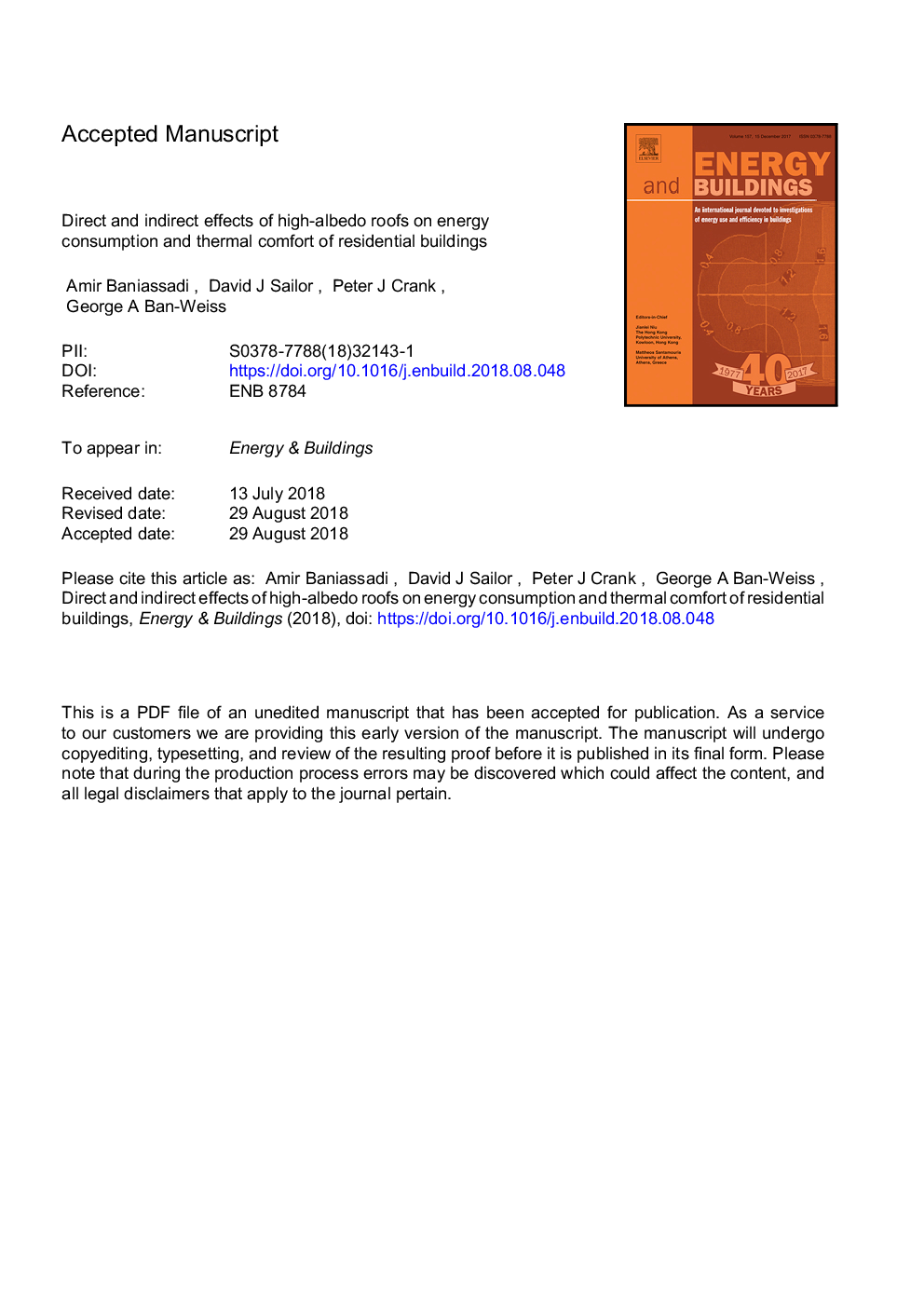| کد مقاله | کد نشریه | سال انتشار | مقاله انگلیسی | نسخه تمام متن |
|---|---|---|---|---|
| 10145822 | 1646369 | 2018 | 26 صفحه PDF | دانلود رایگان |
عنوان انگلیسی مقاله ISI
Direct and indirect effects of high-albedo roofs on energy consumption and thermal comfort of residential buildings
ترجمه فارسی عنوان
اثرات مستقیم و غیرمستقیم سقفهای آلبیدو بر مصرف انرژی و راحتی حرارتی ساختمانهای مسکونی
دانلود مقاله + سفارش ترجمه
دانلود مقاله ISI انگلیسی
رایگان برای ایرانیان
کلمات کلیدی
سقفهای آلبیدو بالا، مصرف انرژی ساختمان، راحتی حرارتی، آب و هوای شهری، تقاضای خنک کننده، هزینه انرژی،
ترجمه چکیده
در طول سه دهه گذشته، سقف آلابود بالا به عنوان یک استراتژی برای کاهش اثر بخشی گرمایی شهری و کاهش تقاضا و هزینه های انرژی خنک سازی ارتقا یافته است. علاوه بر این، سقف های آلبیدو بالا می تواند راحتی حرارتی در ساختمان های غیر متعارف را افزایش دهد. مزایای صرفه جویی در انرژی و راحتی حرارتی از این سقف ها دارای دو جزء است: 1- مزایای مستقیم به ساختمان های فردی با کاهش تابش اشعه مایع جذب شده از طریق سقف و 2- مقیاس های غیرمستقیم در محدوده به دلیل کاهش دمای هوا، به ویژه هنگامی که سطوح بالا آلبیدو در مقیاس وسیع اعمال می شوند. این مطالعه تلاش برای تعیین اهمیت نسبی این مزایای مستقیم و غیر مستقیم و شناسایی چگونگی تاثیر ساخت و ویژگی های آب و هوایی آنها است. ما با استفاده از شبیه سازی انرژی کامل ساختمانی مجموعه ای از ساختمان های مجتمع مسکونی تنها در سه مکان با ویژگی های متمایز در منطقه لس آنجلس (یک ساحلی و دو داخلی) استفاده می کنیم. شبیه سازی های ما نشان می دهد که مزایای اثر غیرمستقیم می تواند به همان اندازه مقادیر به عنوان اثرات مستقیم باشد. مهمتر از همه، این مزایا به ویژگی های آب و هوا و ساختمان بستگی دارد. بالاترین انرژی و مزایای راحتی حرارتی در یک ساختمان با عملکرد پایین (تعریف شده توسط هوادهی و سطح عایق سقف) در لانگ بیچ، که در آن شبیه سازی ها نشان می دهد صرفه جویی در انرژی 41٪ و بهبود راحتی حرارتی 23٪ به دلیل ترکیبی از مستقیم و اثرات غیر مستقیم
موضوعات مرتبط
مهندسی و علوم پایه
مهندسی انرژی
انرژی های تجدید پذیر، توسعه پایدار و محیط زیست
چکیده انگلیسی
Over the past three decades, high-albedo roofing has been promoted as a strategy to mitigate the urban heat island effect and reduce cooling energy demand and costs. In addition, high-albedo roofs can increase thermal comfort in non-conditioned buildings. Energy saving and thermal comfort benefits from these roofs have two components: 1- Direct benefits to individual buildings by reducing absorbed shortwave radiation through the roof, and 2- Neighborhood-scale indirect benefit resulting from reduced ambient air temperatures, particularly when high-albedo surfaces are deployed on a large scale. This study is an effort to quantify the relative importance of these direct and indirect benefits and identify how they are affected by building and climate characteristics. We used whole-building energy simulations of a set of archetypical single family residential buildings in three locations with distinct characteristics within the Los Angeles area (one coastal, and two inland). Our simulations show that benefits from the indirect effect can be the same order of magnitude as the direct effects. More importantly, these benefits depend on the climate and building characteristics. The highest energy and thermal comfort benefits were observed in a low-performance building (defined by airtightness and ceiling insulation level) in Long Beach, where simulations indicated an energy savings of 41% and thermal comfort improvement of 23% due to a combination of direct and indirect effects.
ناشر
Database: Elsevier - ScienceDirect (ساینس دایرکت)
Journal: Energy and Buildings - Volume 178, 1 November 2018, Pages 71-83
Journal: Energy and Buildings - Volume 178, 1 November 2018, Pages 71-83
نویسندگان
Amir Baniassadi, David J Sailor, Peter J Crank, George A Ban-Weiss,
